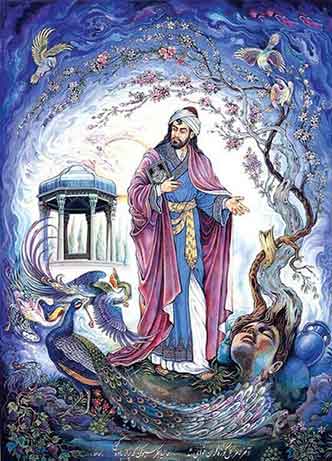Seyed Hashem Moosavi
Introduction
The 20th of Mehr, corresponding to October 12th, is the day of commemoration of Hāfez, the renowned poet of the Persian language. This day, named ‘Hāfez Day,’ was established in honour of his elevated status and his literary and cultural services, proposed by the Islamic Republic of Iran and approved by the UNESCO General Conference in 1987, coinciding with the 600th anniversary of his passing. On this occasion, this week’s article is dedicated to reviewing a part of his thoughts and enduring legacy, so that generations less familiar with Hāfez may become better acquainted with this cultural treasure of Iran and the world.
Khwāja Shams al-Dīn Muhammad Hāfez of Shiraz (born around 727 AH / 1326 CE in Shiraz – died 792 AH / 1390 CE) is regarded by many not only as the greatest lyric poet in the Persian language, but also as a universal figure whose poetry has transcended time and place. Born into a family of learning and culture in Shiraz, Hāfez showed remarkable talent from an early age in mastering religious and literary sciences. He studied the Qur’an, jurisprudence, hadith, exegesis, philosophy, and Arabic literature in the schools of his hometown, and in his youth, he memorized the entire Qur’an with deep understanding and reflection – hence the title Hāfez (“the memorizer of the Qur’an”).
His profound command of Qur’anic teachings, combined with his poetic genius, allowed the verses of the Qur’an to shine throughout his poetry, making his ghazals an artistic expression of spiritual insight and moral wisdom.
In Iranian homes, his Divan holds a revered place beside the Qur’an, and throughout history his poetry has served as a source of guidance, comfort, and inspiration for countless generations. Yet beyond literary beauty, Hāfez stands as a mentor of the soul and a teacher of ethics – a poet whose vision of life, faith, morality, and society continues to offer timeless guidance. In our own time, when religious education faces new and complex challenges, revisiting the message of Hāfez can open new horizons for scholars, preachers, and teachers of faith.
Religious Hopefulness in Hāfez’s View
One of Hāfez’s prominent messages is an invitation to hope amidst darkness. In an era when people faced political turmoil, economic hardships, and social crises, he repeatedly reminded through poetry that despair and hopelessness have no place in the logic of faith.
هاتفی از گوشهٔ میخانه دوش گفت ببخشند گنه، مِی بنوش
A celestial voice from the corner of the tavern said last night: “They will forgive sins, drink wine!
لطفِ الهی بِکُنَد کارِ خویش مژدهٔ رحمت برساند سروش
Divine grace will accomplish its own task; The angel Gabriel brings tidings of mercy.
لطفِ خدا بیشتر از جرمِ ماست نکتهٔ سربسته چه دانی؟ خموش
God’s grace is greater than our sin, what do you know of the hidden mystery? Be silent!”
In this ghazal, Hāfez, through a symbolic and subtle language, conveys a message brimming with hope in God’s boundless mercy towards humanity. The “celestial voice of the tavern” is, in reality, the inner call or divine inspiration that reminds the poet, and indeed all human beings, that the threshold of God is no place for despair. Even if a person is tainted by error and shortcoming, Divine grace and mercy are far more vast than to be measured by the sins of the limited servant.
In these verses, two fundamental points about the relationship between the servant and the Lord are raised:
- God’s Generosity in Forgiveness: Divine forgiveness precedes sin; as the sacred hadith states: «سبقت رحمتی غضبی؛ “My mercy precedes My wrath.”
- The Placement of Hope alongside Reverence: Hāfez emphasizes that God’s grace is greater than our crime; yet, on the other hand, our limited intellect cannot comprehend the secret of this greatness and its manner, and the only right path is silence accompanied by submission and hopefulness.
This interpretation holds a message for all generations, especially today’s youth who grapple with various forms of despair. Hāfez teaches in this poem that “hope in Divine mercy” is not an illusion but a truth deeply rooted in faith and religious knowledge, and one should never despair over their errors and weaknesses. Just as the Holy Quran states: « قُلْ يَا عِبَادِيَ الَّذِينَ أَسْرَفُوا عَلَىٰ أَنفُسِهِمْ لَا تَقْنَطُوا مِن رَّحْمَةِ اللَّهِ إِنَّ اللَّهَ يَغْفِرُ الذُّنُوبَ جَمِيعًا إِنَّهُ هُوَ الْغَفُورُ الرَّحِيمُ؛ “Say, ‘O My servants who have transgressed against themselves [by sinning], do not despair of the mercy of Allah. Indeed, Allah forgives all sins. Indeed, it is He who is the Forgiving, the Merciful.’” (Surah Az-Zumar, 39:53)
Hāfez, using symbols such as Badeh “wine” (divine love and knowledge), Maykhaneh “tavern” (the sanctuary of mercy), and Rind[1] (the sincere and unpretentious person), has embedded this hopefulness in various layers of his poetry. Hāfez’s perspective is an encouraging and life-giving one that guides humanity, even in the darkest moments, towards the light of Divine mercy.
Moral Education and the Avoidance of Hypocrisy
One of the main themes in Hāfez’s Divan is the critique of hypocrisy and the peddling of religion. Through satire and irony, he depicts hypocritical ascetics who claim religion outwardly but are inwardly trapped in pride and corruption.
Hāfez’s distinguished characteristic is that he knows himself well and does not seek pretension and ostentation. This very integrity has given him the courage to fearlessly assail falsehood and hypocrisy. Hāfez is the enemy of anyone who deceives people, be they preachers and ascetics or merchants and traders. His weapon is a speech full of satire and perceptiveness, and he employs the terms May “wine” and Maykhary “wine-drinking” as tools to expose hypocrites.
From his viewpoint, a hypocrite is someone who has a sanctimonious face but, behind the appearance of religiosity, is enslaved by the ego and worldly attachment. Hāfez repeatedly warns that “asceticism and hypocrisy burn the harvest of faith,” and even if he himself wears a Sufi cloak, he introduces it as a veil covering a hundred hidden faults.
خرقه پوشي من از غايت دينداري نيست پردهي بر سر صد عيب نهان ميپوشم
My wearing of the cloak is not due to ultimate piety. I am covering a veil over a hundred hidden faults.
He has no quarrel with true people of faith; rather, his defence is precisely of genuine religiosity. His problem is with those who make religion a means of deception and power-seeking. In this struggle, Hāfez utilizes the concept of “wine” and “rindī” (which in his literature means freedom from pretence and purity of heart) like a sharp sword to tear away the veil from the faces of those ascetics, Sufis, and others who make the Quran a tool of deception.
حافظ ميخور و رندي كن و خوش باش ولي دام تزوير مكن چون دگران قرآن را
Hāfez, drink wine, be a ‘rind’, and be joyful, but do not make the Quran a snare of deception like others.
Hāfez clearly stood against those authoritarians who gained spiritual and worldly influence by relying on the simplicity of the people. With his perceptive mind and ‘rind-like’ language, he exposed these deceptions; in such a way that the apparent form of his poems seemed simple and mystical, but the aware and vigilant people well understood that his goal was to expose the hypocrites. This is why many of Hāfez’s allusions and ironies have remained comprehensible and inspiring throughout all eras.
This message is also highly instructive for the field of religious propagation today. A society where ethics and sincerity do not replace slogans and hypocrisy cannot witness spiritual flourishing.
Joy and Beauty in Religiosity
One of the secrets behind the endurance and popularity of Hāfez in the hearts of various generations lies not in complex concepts, but in his “vibrant language and aesthetic perspective.” Hāfez does not see religion in opposition to joy and vitality; rather, he presents it as full of true delight and intoxication. For him, spirituality does not smell of mustiness and stagnation, but carries the fragrance of May “wine,” “flower,” and “the sound of the reed flute.”
With unparalleled delicacy, Hāfez removes religiosity from the Mold of a “heavy obligation” and transforms it into a “romantic experience”:
مزرع سبز فلک دیدم و داس مه نو یادم از کشتهٔ خویش آمد و هنگام درو
I saw the green field of the sky and the crescent moon’s sickle, I remembered my own harvest and the time of reaping.
In this couplet, he sees the world as a green and beautiful field, and the Resurrection not as a day of terror, but as the time of “reaping” and the fruition of deeds. This perspective replaces pure fear with beauty and a deep connection with the system of existence.
From Hāfez’s viewpoint, religiosity is not a heavy burden, but an experience full of joy and light-heartedness.
مباش در پی آزار و هر چه خواهی کن که در شریعت ما غیر از این گناهی نیست
Do not seek to harm, and do whatever you wish, for in our religious law, there is no sin other than this.
This couplet is essentially the refrain of the same teaching that the Prophet of Mercy (peace be upon him and his progeny) also recommended: «يَسِّروا وَلا تُعَسِّروا ، وَسَكِّنوا وَلا تُنَفِّروا؛ “Make things easy and do not make them difficult, give glad tidings and do not repel people.” (Sahih al-Bukhari: 5/2269/5774). Hāfez depicts this Prophetic tradition in the most beautiful form through poetry. In an age where many equate religion with dryness and strictness, drawing upon Hāfez’s language can present a fresh, attractive, and delightful face of spirituality.
Hāfez and Cultural-Religious Identity: A Bridge Between the Heart and Religion
Hāfez’s poetry is a bridge between Islamic identity and Iranian culture. By utilizing Quranic, mystical, and ethical concepts, he transformed the Persian poetic language into a medium for conveying the message of religion.
He speaks of “Kawthar” and “Tasneem,” but alongside them, he also speaks of the “tulip” and the “cypress”; he recalls the “Day of Alast” and interweaves it with the “beloved” and the “cupbearer,” thus recreating sublime concepts in the form of familiar and pleasant symbols for the Iranian audience.
Today, propagators can also use Hāfez’s poems to link the cultural roots of nations with religious teachings. This is especially effective in international environments, where speaking of religion must be offered subtly, indirectly, and delightfully. Hāfez provides us with the very language that breaks borders and speaks to every human being anywhere in the world based on a shared human nature. When Hāfez recites:
غلام همت آنم که زیر چرخ کبود ز هر چه رنگ تعلق پذیرد آزاد است
I am a slave to that ambition which, under the azure sky, is free from everything that accepts the colour of attachment.
It is no longer about a specific geography or ethnicity; it is about freedom and liberation, a value that every free heart respects. This is Hāfez’s art: “The crystallization of universal religious concepts in the aesthetic mirror of Iranian culture.”
Conclusion
Hāfez is not merely a classical poet; he is a spiritual teacher and an ethical inspiration whose messages remain alive and effective for the religious education of our time.
- He calls us to hope and trust in Divine mercy.
- He defines faith with affection and love.
- He warns against hypocrisy and ostentation.
- He speaks of a vibrant and beautiful religiosity.
- And he establishes a link between culture and faith.
Therefore, if today’s scholars and Friday prayer Imams utilize Hāfez’s language in their sermons and teachings, they will not only find a place in people’s hearts but will also convey religious teachings to society in a subtle, profound, and inspiring manner. Hāfez is a treasure whose revisitation can reconcile the new generation with the truth of religion and open a new path for effective propagation in the challenging world of today.
[1] . Rind: one who is free-spirited, unpretentious, often feigning disregard for conventions.






